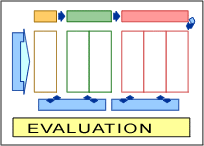Home » Enhancing Program Performance with Logic Models » Section 7: Using Logic Models in Evaluation
Section 7: Using Logic Models in Evaluation

Section Overview
In addition to helping you plan a program, the logic model can help you measure your outcomes and improve your evaluation practice. In this section you will learn how the logic model can help you determine what to evaluate, identify appropriate questions for evaluation, select indicators, know when to collect data and determine what data collection methods are most appropriate.
This section presents the logic model as fundamental for these aspects of evaluation planning. Two other parts of evaluation planning — data analysis and interpretation, and use of results — are not covered here, although they are part of a comprehensive evaluation plan.
This section is not an evaluation primer. Its purpose is to show how the logic model can facilitate more effective and efficient evaluation and covers evaluation issues the logic model can help you with. It does not cover the many technical aspects of evaluation, such as measurement, instrument construction, sampling design, etc. Other resources will be referenced for those areas.
Section Goal
When you complete this section, you will see how the logic model helps in evaluation. More specifically you will:
- Recognize how the logic model helps determine what you will evaluate – the focus of your evaluation.
- Recognize how the logic model helps you determine meaningful and useful evaluation questions – know what to measure.
- Understand indicators and know what information best answers your evaluation questions.
- Be able to identify appropriate timing for data collection.
Section Outline
You can use this outline to move through the topics in this section.
- Where does evaluation fit in a Logic Model?
- How do Logic Models help in evaluation?
- What to evaluate? – The focus
- What will the evaluation seek to answer? – The questions
- Who will use the evaluation?
- Example of a Logic Model with evaluation questions
- Common categories of evaluation questions
- Clarifying the evaluation question(s)
- How will you know it? – The indicators
- Logic Models and indicators
- Selecting meaningful indicators
- Examples of indicators
- Properties of indicators
- Timing
- Evaluation designs
- Data collection
- Sampling
- Instrumentation
- WRAP-UP: A complete evaluation plan
- Section summary




